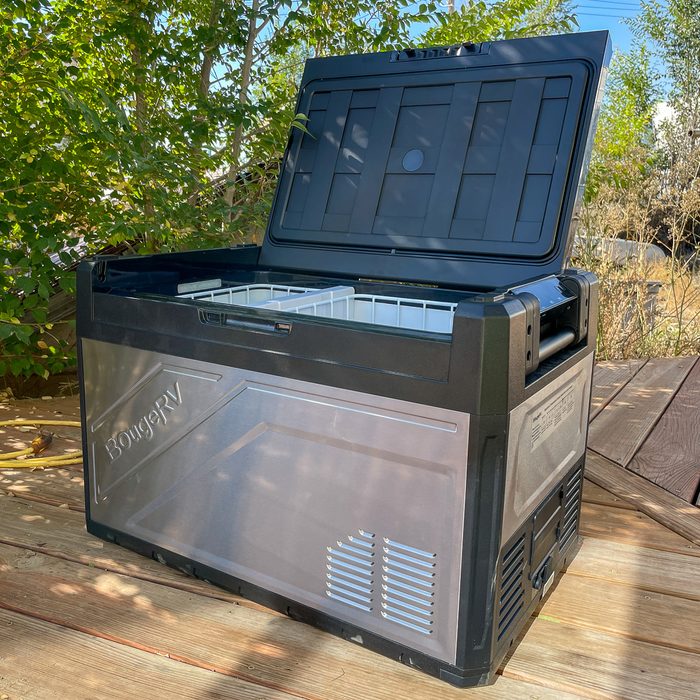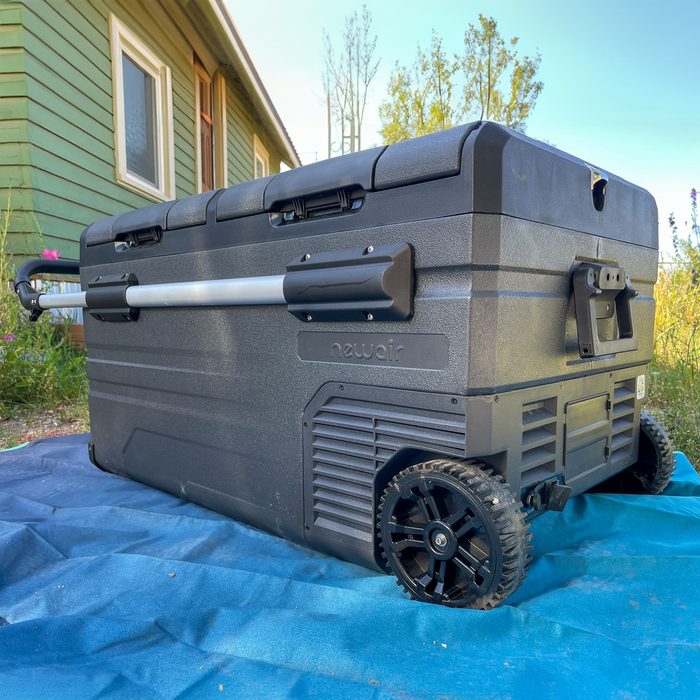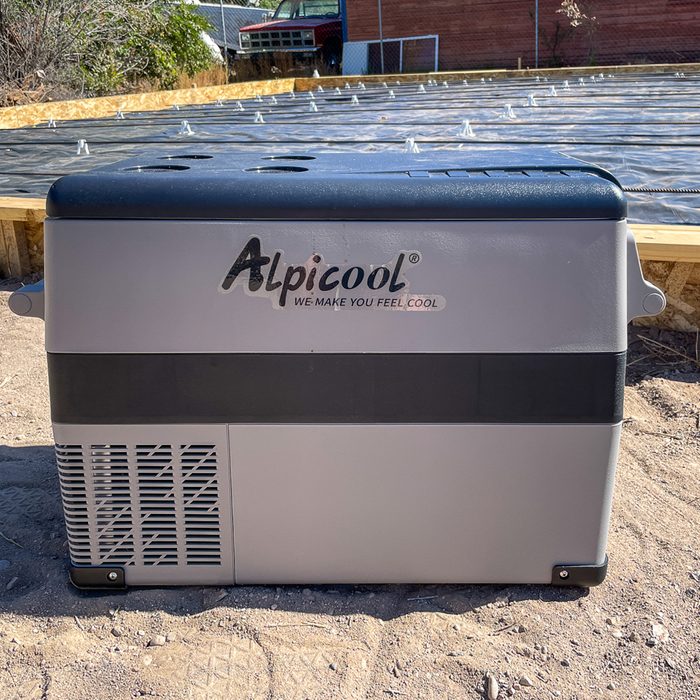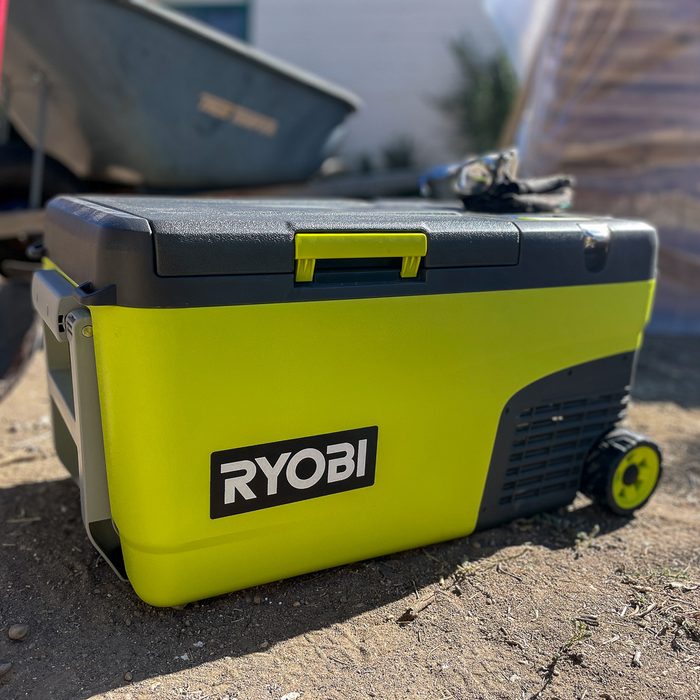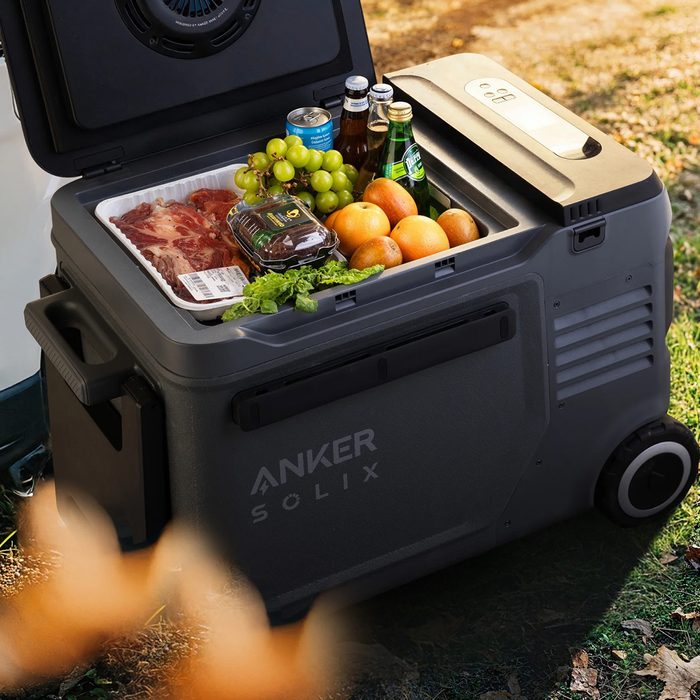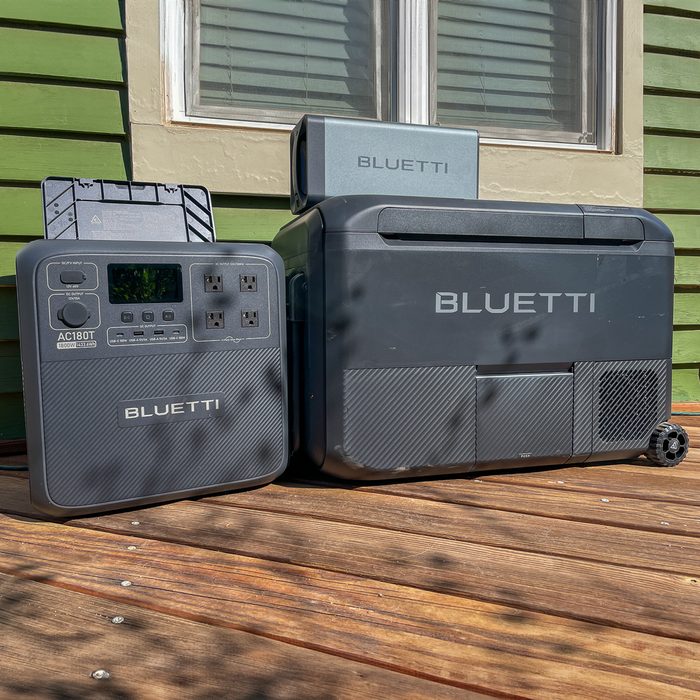KARUNA EBERL FOR FAMILY HANDYMAN
KARUNA EBERL FOR FAMILY HANDYMAN
Pros:
-
Automatic ice maker with water reservoir
-
200W solar charging (battery and panels required)
-
45-degree tilt tolerance
-
Unique, long-lasting battery setup (extra purchase)
Cons:
-
Expensive to buy battery/power station option
On its own, Bluetti’s MultiCooler Fridge has many good features, including a self-cleaning ice maker. But it’s also designed to be paired with Bluetti’s large B70 modular power system batteries, which makes it a smart option if you’re planning on being off the grid for a while, whether that’s on a day-long beach picnic or an indefinite voyage on a live-aboard boat.
KARUNA EBERL FOR FAMILY HANDYMAN
The cooler has a 42-quart capacity main compartment plus a 9.5-quart ice/freezer section. We found it ran quietly, except when the ice maker was engaged. That racket took about 24 minutes for the first batch and about half of that for subsequent batches. The Bluetti cooler will, however, pause cooling in the main compartment while ice is being made. As a bonus, it automatically drops completed cubes into the ice compartment.
Bluetti’s MultiCooler is also a good choice for off-roaders. Like the Alpicool, it has a 45-degree tilt tolerance and recessed metal sidebars. As we took it up a rocky mountain pass, we appreciated being able to use those to strap it down securely. Even though it’s a bit heavy to lift, it pulled decently around camp, and I liked the padded handle. The wheels are rather small, though, so it’s a bit of a bear over rough terrain.
Other helpful features include USB-A and USB-C ports for charging electronics and a removable lid. I also particularly appreciate that its food baskets have a smaller wire pattern than most other coolers. This means bottles stand upright better, and food doesn’t fall through when you pick the whole basket up to unload it.
KARUNA EBERL FOR FAMILY HANDYMAN
The power system can be plugged into a wall outlet or a 12V car socket or used with one of Bluetti’s B70 batteries (sold separately), which each carry an impressive 716 watt-hours. Once one of those is in, you can add up to 200W of solar charging to the mix.
Bluetti encourages pairing the MultiCooler Fridge with its AC180T Power Station, which holds two B70 batteries. By doing this, you can expand your battery capacity indefinitely by buying more B70s and charging them through the AC180T. It’s also a handy option because you can get a lot of power without having to lug a full power station around — just grab a battery or two as you need them. If you can afford it, we’ve found the cooler plus AC180T to be a great, versatile package since you can also use the AC180T as a power station for all sorts of other electricity needs.
Capacity: 42 Quarts | Weight: 53 Pounds | Power Draw: 65-watt | Dual Zone: Yes | App Controlled: Yes
KARUNA EBERL FOR FAMILY HANDYMAN
KARUNA EBERL FOR FAMILY HANDYMAN
Pros:
-
Dual-zone, with two doors
-
Quiet
-
Optional 960 Wh battery
-
Durable, great warranty
-
Low power draw
-
Large capacity
Cons:
-
Expensive
-
No wheels or handle
We adore this dual-zone Dometic, partly because it was our first electric cooler but also because after three years of heavy use and flat-out abuse—including exposure to dust storms, extreme heat and thousands of rocky off-road and washboard miles—it’s still going strong. It even saved us hundreds of dollars in food when our house fridge broke down.
KARUNA EBERL FOR FAMILY HANDYMAN
With a 79-quart capacity, it’s among the largest electric coolers on the market, comparable to the Newair model in this write-up. Dometic is known for making particularly good yet expensive RV appliances, and this model is no exception. It’s more than twice the price of the Newair (but still the same price as the EcoFlow Glacier), which is the main reason why we awarded the Newair the best dual-zone electric cooler instead of this one.
The Dometic cooler is also a lunker. Empty, it weighs 61 pounds. Full, it takes two people to carry it (I finally wised up and now take the baskets of food out first before lugging it long distances, duh). It doesn’t come with wheels or a pull handle, either, but you can buy a slide and tie-down kit for it, which is nice if you’re planning on installing it in your van or camper.
KARUNA EBERL FOR FAMILY HANDYMAN
But this cooler does hold a lot of food, and it’s very sturdy. Dometic doesn’t list any internal component specs, but after the thousands of hours we’ve run it, it’s safe to say they are of high quality. Cosmetically, however, we have managed to chip the decorative plastic on the outside, but that’s been easily fixable with a bit of J-B Weld. Oh, and the compressor is also very quiet.
Despite its size, it’s great at power conservation, drawing only 60 watts when the compressor is running (25% less power draw than the Newair). Dometic also sells 200 Wh and 960 Wh batteries, which attach to the outside and have solar ports. We never opted for that option, though, since we have a portable power station to run it from when we’re off-grid. Dometic makes a range of other electric coolers, too, all the way up to a 104-quart beast.
Capacity: 79 Quarts | Weight: 61 Pounds | Power Draw: 60-watt | Dual Zone: Yes | App Controlled: Yes
What to Look for When Buying an Electric Cooler
Cooling Technology
There are two main categories of cooling technology being used in electric coolers: compressor and thermoelectric. Thermoelectrics generally use less power, are lighter, and don’t contain potentially environmentally harmful refrigerants. On the downside, they don’t get nearly as cold, especially when it’s hot outside. If a cooler doesn’t advertise zero or sub-zero cooling, it’s probably thermoelectric.
If you live in a cool place or just need to keep some veggies from spoiling, a thermoelectric might do the trick.
"If your trip is long or you work under hot conditions, the compressor model will provide far more dependable performance."
Yashar Mosaferi
CEO of Klondike AC
Compressor Technology
Most people opt for a cooler with a compressor, but not all compressors are the same. “Recent compressor technology developments, such as variable-speed and inverter compressors, are more energy-efficient compared to traditional or single-speed compressors”, says Yashar Mosaferi, CEO of Klondike AC. “To ensure that you get the latest compressor technology, look for the term ‘inverter technology’ in product descriptions”, he says. (Note: We have yet to see an electric cooler brand touting what compressor tech they’re using.)
Size and Weight
KARUNA EBERL FOR FAMILY HANDYMAN
With an electric cooler, you’ll save internal space that would be filled with ice. But, because of the compressor size, electric coolers are larger overall than regular coolers. So when deciding what size to get, consider both the inner capacity and the outer dimensions, as well as the weight—because these guys can get pretty hefty.
Power Options
Most models can be powered through a wall or generator outlet (AC), 12V car outlet (DC) or built-in/detachable lithium batteries. A few come with the batteries, but most are an additional purchase. Many have built-in solar inputs as well. Otherwise, if you want to power your cooler via the sun, you could bring along a portable power station with solar panels.
Energy Use (Watt-hours)
The energy efficiency of electric coolers depends on their compressor technology and the quality of insulation. If you’re just plugging your electric cooler into the wall, then how many watts it uses isn’t much of a factor. But if you’re running it off of a battery, a battery being recharged by solar, or your car/RV battery, then more efficient models make life a lot easier.
When calculating how many watt-hours it will take to run a portable cooler, keep in mind that the compressor won’t be running once the cooler is down to temperature. Of course, the more you open the lid or the hotter it is outside, the more the compressor will run and the more watt-hours it will consume.
Cooling Zones
Some larger-capacity electric coolers offer dual-zone cooling, which means one side can be a refrigerator and one a freezer. Often with these, you can also set both sides as a fridge or both as a freezer. The better ones have independent lids for each side. Note: A few models have two sides but can’t be set at independent temperatures, so check that before you buy if that’s an important feature for your needs.
Other Features
KARUNA EBERL FOR FAMILY HANDYMAN
Other features that can add to your portable cooler bliss include:
- Adjustable temperature controls
- Durable construction for outdoor use
- Wheels and a pull handle, especially for larger models
- USB charging outlets for phones and other devices
- Bluetooth or Wi-Fi app controls.
Note: None of the models we tested have warming options, but some thermoelectric models, like the 4Patriots Freedom Fridge, can actually heat compartments up to 149 degrees F.
How We Found the Best Electric Coolers
After analyzing 15 electric cooler manufacturers, we settled on 8 we wanted to try. We opted for models with various sizes and features to ensure we included ones for an array of uses, from job sites and picnics to extended car and RV camping.
From there, we evaluated each on its power efficiency (watt-hour use), size and weight, price, power options, cooling zones, pull handles and wheels and other user interfaces. We also tested how well they performed in various scenarios over the course of the summer, including:
- How long it took to freeze trays of ice
- How fast they were able to get down to temperature
- How well they held their temperature in the heat
- How easy it was to clean up spills
- How practical they were for packing food and
- How easy they were to transport.
After adding all of that up, we picked our favorites for various uses, whether that meant going to the beach, living on the road or storing drinks for the crew.
Other Electric Coolers We Tested
- Igloo Iceless Portable Electric 40-quart Cooler: This electric cooler is affordable and easy to carry, being less than 19 pounds. It also draws very little power since it uses thermoelectric technology, compared to the compressors used in the rest of the coolers we tested. If you live in a cool climate and don’t need freezer temperatures, this could be a realistic choice. Also, if you start with frozen food and don’t open the lid, this cooler could keep it from spoiling for a couple of days, so long as it’s not parked in the sun. But otherwise, the technology can only effectively make it 38 degrees cooler than the ambient air temperatures, which means it’s really only practical if it’s less than 60 degrees outside.
FAQ
How long do electric coolers stay cold?
It depends on the power source you’re using. If it’s plugged into a wall outlet, it will stay cold indefinitely. If it’s running off of a battery, it depends on how many watts the battery holds versus how many watts the cooler is drawing. Most coolers that come with batteries advertise between 4 and 40 hours of runtime, though that will be largely affected by the outside air temperature and how often you open the cooler (which will make the compressor have to run more often). If the electricity gets cut off, as long as you don’t open the lid, most electric coolers will still keep your food from spoiling for several hours or even days, similar to a regular cooler.
Can you leave an electric cooler plugged in all the time?
Yes. Electric coolers can stay plugged in indefinitely, though as with any appliance, eventually, the compressor or other parts may wear out.
Can you put ice in an electric cooler?
Yes. In fact, if you don’t have a way to power your electric cooler, you can just put ice in and use it as a regular cooler. But if you do have power, it’s better to avoid using ice since, as it melts, the excess moisture can reduce the efficiency of the insulation, thereby increasing the workload on the compressor or thermoelectric cooling system, plus making your food soggy and leak out of drains that might not be fully sealed. Ice trays for drinks are an exception since the ice is neatly contained. Some electric coolers even include ice makers.
Why You Should Trust Us
My partner and I have been testing and writing about outdoor, camping and workshop products for nearly 30 years. For the last three years, we’ve been putting electric coolers and portable power stations through the wringer, from high-elevation mountains to vast deserts and even tropical islands. We’ve been using them for car and van camping, including weeks-long remote overland expeditions, where solar was the only power source. Back at home, we’ve also been testing electric coolers on our job site and building a new workshop.
Amanda Capritto, content updates editor at Family Handyman, contributed research to and updated this guide. Amanda is a commerce journalist and editor who has written reviews for Garage Gym Reviews, BarBend, Reader’s Digest and more.
Sources
- Yashar Mosaferi is CEO of Klondike AC. He has worked in HVAC and cooling for nearly a decade and is well acquainted with compressor technology and its application to residential and commercial cooling solutions, including portable electric coolers.
- Tom Callahan is Senior VP of Product Development and Customer Experience at 4Patriots, an e-commerce provider of camping, emergency and preparedness products, where he is responsible for product innovation and R&D.





















